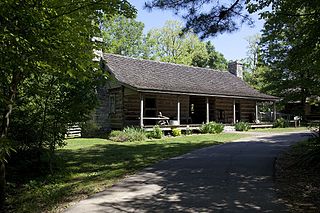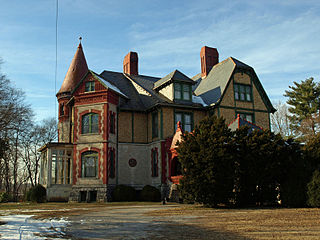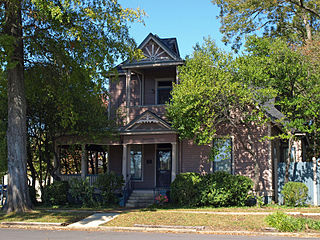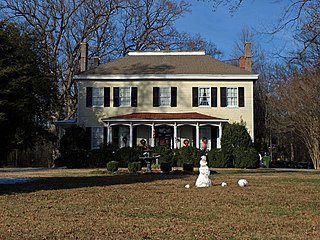
The White House of the Confederacy was the executive residence of President Jefferson Davis and family while the capital of the Confederate States of America was in Montgomery, Alabama. Completely furnished with original period pieces from the 1850s and 1860s, the 1835 Italianate-style house is open to the public. It has been listed on the National Register of Historic Places since 1974 and the Alabama Register of Landmarks and Heritage since 2012.

Signal's Lily Flagg 31035 (1884–?), also spelled Flag, was a Jersey cow, the top butter producer in the world in 1892, owned by W. E. Matthews and General Samuel H. Moore of Huntsville, Alabama. During her record-breaking year, she weighed 950 pounds (430 kg) and produced 1,047 pounds 3⁄4 ounce (474.93 kg) of butter. Her parents were sire Georgian 6073 and dam Little Nan 15895.
The J. D. Holman House is a historic residence in Ozark, Alabama. One of the most elaborate Neoclassical homes in the Wiregrass Region, it was built in 1912–13 for Jesse DeCosta Holman, a prominent local merchant. The house was listed on the National Register of Historic Places in 1982.

Burritt on the Mountain is an open-air museum in Huntsville, Alabama. The museum grounds on Round Top Mountain, a plateau connected to Monte Sano Mountain, were the estate of local physician William Burritt, who willed his house and land to the city for use as a museum upon his death in 1955. A number of 19th-century rural structures have been added to Burritt's mansion, both in the interest of historical preservation and life re-enactment.

The Joel Eddins House is a hall-and-parlor log house on the grounds of Burritt on the Mountain in Huntsville, Alabama, and is the oldest documented building in the state. The house was built in 1810 near present-day Ardmore in Limestone County, Alabama, by Joel Eddins, a settler from Abbeville County, South Carolina. It was moved from its original site to Burritt in 2007. The 1+1⁄2-story house is a hall-and-parlor style, not commonly found in Alabama. An addition was built in the 1930s to the rear, which wrapped around part of the east side; it was not retained when the house was moved to Burritt. The gable roof has brick chimneys on the ends. The main entry opens into the larger "hall" room, which contains a fireplace on the west wall and doors on the other two. A quarter-turn staircase in the northeast corner leads to the upper floor. The eastern door leads to the "parlor" with another fireplace and staircase. The upper floor rooms are the same size as those below, and are not connected. Each room has two small, four-pane windows on either side of the chimney. The 1930s addition contained a bedroom, bathroom, and kitchen. The house was listed on the National Register of Historic Places in 1996.

The Gen. Mason J. Young House, also known as the William Boyd House, is a historic house and connected farm complex at 4 Young Road in Londonderry, New Hampshire. With a building history dating to 1802, it is a well-preserved example of a New England connected farmstead. The house was listed on the National Register of Historic Places in 1986.

Flint River Place is a historic residence near Huntsville, Alabama. The house was built between 1844 and 1850 by Daniel Friend, a planter who came to Alabama from Kentucky around 1826. The house is Greek Revival in style, with Federal and Georgian Revival elements. It began as an L-shaped house, with an additional ell and one-story shed roofed infill built in 1930. The house is clad in poplar siding and the gable roof was originally slate over wooden shingles, but has been replaced by asphalt shingles. Two gable-end chimneys have simple, Federal-style mantels. The façade is three bays, with a one-story portico supported by four columns, with a balcony above; it replaced a gable-roofed, two-column portico in 1978. The main entrance is flanked by sidelights and topped with a fanlight. Windows on the entire house, except for the southeast bedroom addition, are six-over-nine sashes. The house was listed on the Alabama Register of Landmarks and Heritage in 1981 and National Register of Historic Places in 1982. The house was heavily damaged in a fire in 2012.

The White–Turner–Sanford House is a historic residence in Huntsville, Alabama. It was built in 1827 by James White, a merchant from Virginia, on land purchased from LeRoy Pope. The home has had numerous owners through the years including John H. Lewis, mayor from 1826 to 1828, and state representative George W. Lane. Originally a one-story Federal-style house, a two-story Greek Revival addition was built in 1858. The original part of the house consists of a center-hall main block with an ell. It is built of brick laid in common bond, with a gable roof. A portico supported by four thin columns covers the main entrance, which sports a four-panel transom. Windows on the main block are the original rectangular sashes, except the windows on the façade which were modified with segmental arched tops to match the addition. The original portion contains a hall flanked by a parlor and reception room, with two bedrooms behind the parlor. A porch, kitchen, and bath filling in the ell were added after the Civil War. The addition has a study and dining room on the ground floor and two bedrooms above. The house was listed on the National Register of Historic Places in 1984. It has been converted into a financial planning office.

The Kildare–McCormick House is a historic residence in Huntsville, Alabama. The highly ornate, Queen Anne-style mansion was built in 1886–87. Its early owners contributed to the development of Huntsville, both through industrial projects and philanthropic efforts. The house was listed on the National Register of Historic Places in 1982.

The Vaught House is a historic residence in Huntsville, Alabama. It was built in 1900 in what was then the East Huntsville Addition, a suburb made up primarily of company houses for nearby cotton mills. Its Victorian architecture style set it apart from its more modest bungalow neighbors. The house has an irregular plan, and its hipped roof features several dormers and gables. Centered on the façade is a single-story pedimented portico leading to the main entrance, and above it is a small pedimented balcony accessed from the upstairs bedroom. Both pediments are decorated with jigsawed designs. Both doors on the front feature rectangular transoms. A curved porch runs from the main portico around the southwest corner of the house; it originally featured Stick-Eastlake style frieze and balustrade, but was later replaced with a solid frieze and closely spaced rectangular balusters. The house was listed on the National Register of Historic Places in 1981. It is included in the Five Points Historic District, which was listed on the National Register in 2012.

The Yarbrough Hotel is a historic building in Huntsville, Alabama. The four-story structure was built of brick and reinforced concrete in 1922–25. The top three floors contain 75 rooms, while the ground floor features the hotel lobby and storefronts; as it did not have a ballroom or party rooms, it catered to businessmen. It faced competition from the Twickenham Hotel one block away, and the Russel Erskine Hotel. Yarbrough operated as a residential hotel until the late 1950s, and was renovated in the 1980s.

Oak Place is a historic residence in Huntsville, Alabama. It was built by renowned Huntsville architect George Steele in 1840 on 320 acres. Steele designed a number of buildings across the South, including the First National Bank building in Huntsville, and the second Madison County Courthouse, which stood from 1840 until 1914. Similar to many of his buildings, Steele designed Oak Place house in a Greek Revival style, although much more restrained in detail.

Quietdale is a historic residence in Huntsville, Alabama, US. The house was built in 1854 for Caroline Moore Robinson, the widow of Madison County Sheriff William Robinson. It represents a shift in architecture from Neoclassical to the more eclectic forms that became prominent in the late 19th century.

The Phelps–Jones House is a historic residence in Huntsville, Alabama. One of the oldest buildings in Alabama, it was built in 1818, shortly after the initial federal land sale in Madison County in 1809. Despite having many owners, the original character of the house has remained. The two-story house is built of brick laid in Flemish bond, and has Federal and Georgian details. The original block has a bedroom and parlor separated by a central hall, with a dining room in an ell to the northeast. Staircases in the hall and dining room led to three bedrooms on the second floor. In 1956, a porch in the crook of the ell was enclosed, adding a bathroom and small bedroom. Another porch off the rear of the dining room was enclosed and converted into a kitchen. Interior woodwork, including six mantels, is in provincial Federal style. The façade is five bays wide, with twelve-over-twelve sash windows on the ground floor and twelve-over-eight on the second. A narrow hipped roof porch covers the double front door; originally a wider porch covered a single door flanked by narrow sidelights and topped with a transom. The house was listed on the Alabama Register of Landmarks and Heritage in 1979 and the National Register of Historic Places in 1982.

Greenlawn is a historic residence between Meridianville and Huntsville, Alabama. The house was built in 1849–50 by William Otey, replacing a log house built by his father in the early 1810s. Following William and his wife's deaths, the house was taken over by one of their granddaughters in 1907. Around 1925, the original Italianate portico was replaced with the current Greek Revival entrance, and a northern wing was added. The house fell vacant in 1963 and was later restored, now sitting at the entrance to a subdivision of the same name.

The Monte Sano Railroad Workers' House is a historic boarding house in Huntsville, Alabama, United States. Built in 1888, it is the only remaining building relating to the Monte Sano Hotel and Railroad. The North Alabama Improvement Company built the three-story, Queen Anne hotel on Monte Sano Mountain in 1887. The following year, construction began on a rail line connecting the hotel with the Memphis and Charleston Depot downtown. The house was constructed to house workers building and later operating the railroad.

The McCartney–Bone House is a historic residence near Maysville in Madison County, Alabama. The house was built in 1826 by James McCartney, who came to Madison County in 1810. McCartney held several public offices in the county, including Justice of the Peace, Tax Assessor and Collector, and County Commissioner. He was also a member of the Flint River Navigation Company, which sought to improve transportation along the Flint River to the Tennessee River, making it easier to get goods from northeastern Madison County to market. McCartney died in 1831, and his wife, Martha, remarried twice, the second time to Reverend Matthew H. Bone. After Martha's death in 1885, the house remained in the family until 1955.

The Jude–Crutcher House is a historic plantation house in Huntsville, Alabama. The house was built circa 1812 on land deeded that year to Samuel Echols. Echols sold 54 acres and the house to George Jude, Sr., in 1817. Jude died two years later, leaving the land to his son, George Jr. The younger Jude eventually acquired 800 acres and owned 31 slaves. Upon his death in 1873, the land stayed in the family until 1883. In 1906 David Crutcher, who had been born a slave on an adjacent plantation in 1851, purchased the house and 154 acres along with two other African-American men. The Crutchers operated a successful farm on their portion of the land, which was an extension farm for Alabama A&M University until the 1940s. Only 7% of African-American farmers in Madison County in 1910 owned their own farms. David died in 1924, and his wife, Lucy, died in 1943, although the house and land is still in the family.

The William Lanford House is a historic residence in Huntsville, Alabama. The house was built by William Lanford, a native of Spotsylvania County, Virginia. Lanford's father, Robert, was an early land speculator who came to Huntsville from Nashville along with LeRoy Pope. William purchased 1,975 acres in 1843 and built his house in 1850. Lanford's daughter, Mary, married physician John R. Slaughter in 1853, who later moved his practice to the house in William Lanford's later life. Upon his death in 1881, the land was divided among Lanford's daughters, with Mary and Dr. Slaughter remaining in the house. After Mary's death in 1913, the house was sold to William Olin Camper in 1919. Camper and his brother Robert were merchants in Madison and Huntsville, and owned the Twickenham Hotel in Huntsville.

The Ernest Edward Greene House is a historic residence in Cullman, Alabama. The house was built in 1913 by Ernest Edward Greene, the superintendent of Southern Cotton Oil Company. After Greene's death in 1922, the house was passed on to several more owners, including John George Luyben, Sr., who lived in the house for 34 years.
























